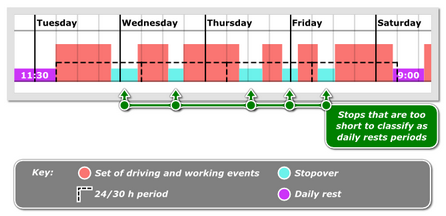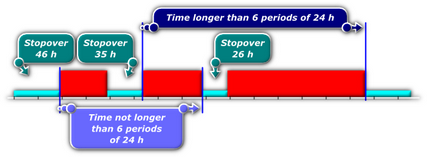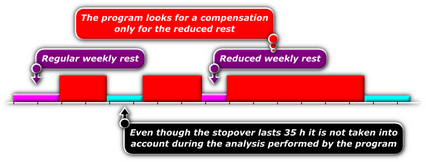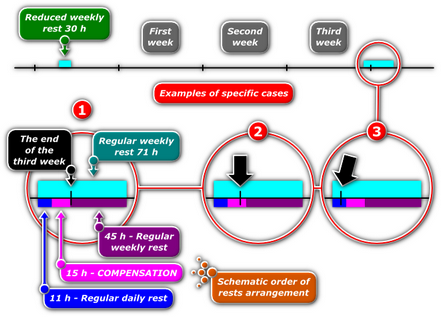The program closes the daily driving period if the daily rest period lasts at least (select the correct option):
•7 hours; •9 hours; |
|

|
Option checked - if the driver does not use the daily rest period of at least 9 hours, according to guideline No. 7 to the European Commission (Social legislation in road transport, Regulation (EC) No 561/2006, Directive 2006/22/EC, Regulation (EU) No 165/2014) the program sets fixed periods of 24 or 30 hours and in each of them is looking for infringement of shortening the daily rest period;

If during the analyzed period of 30 hours all the activities (depending on settings) are in a team, the program sets a period of 30 hours; in other cases 24-hour period is adopted.
Options in the Multi-manning frame ("TachoScan -> Infringements - Tolerance" tab of the program "settings" window) impact determining the activities in a team.
If during the 24/30 hour period there are several stops, the analysis takes into account the longest stop.
|
|
|

|
Option unchecked - analysis of the next 24/30 hour period begins at the end of the daily / weekly rest.
|
|
|
The mechanism of the option was illustrated in the following example:


|
Option checked - the program, as the option name suggests, begins the analysis of rest periods from the marker of the end country and ends it at the marker of the start country. In the case, when the country marker is "inside" of the activity (e.g.: end country marker - Fig. bellow), the program includes the whole event in the analysis.

|

|
Option unchecked - during the analysis, the program assumed the stop at 2:07, driving period as the first rest break, the second stop at 0:39, another driving period as the second rest break and a stop at 8:05. The sum of stops is less than 11h (2:07 + 0:39 + 8:05 = 10:51) - in this case, the program adopted 8:05 as the longest daily rest and thus displayed an infringement.

|
Selecting this option, can improve the analysis of rest periods while on a ferry - it depends on the correct entry of the start country and end country.
If the country start and end markers are entered incorrectly, we recommend unchecking this option.
|
|
|
|
This option refers to the example of the situation shown in the figure below:
 Fig. Driving during the rest on the ferry •(Item 1 - Fig. above) a stop preceding the rest on the ferry; •(Item 2 and item 4) driving during the rest on the ferry; •(Item 3) rest on the ferry; •(Item 5) stop after a rest on the ferry.
Remember:
- the total time of stops no. 1, 3 and 5 must be at least 11 hours (daily rest).
- total driving time no. 2 and 4 may not be more than 1 hour.
|
|
 Option checked — driving no. 2 and 4 will be added to the daily driving time. In this example, the program registers an infringement of daily driving time (10:01). Option checked — driving no. 2 and 4 will be added to the daily driving time. In this example, the program registers an infringement of daily driving time (10:01).
 Fig. Driving included in the daily driving time. |
 Option unchecked — driving no. 2 and 4 will not be added to the daily driving time. In the example shown, the program will register no infringements of daily driving time (9:17 - the first allowed time driving extension to 10h). Option unchecked — driving no. 2 and 4 will not be added to the daily driving time. In the example shown, the program will register no infringements of daily driving time (9:17 - the first allowed time driving extension to 10h).
 Fig. Driving omitted in the calculation of daily driving time. |
|
|
In a situation where within 2 weeks there are 5 exceedances of the daily driving time over 9 hours, where two exceedances take place in the first week, next 2 are in the second week, and fifth at the turn of those weeks, the program:

|
Option checked - does not show an offense;
|

|
Option unchecked - shows an offense.
|
This option applies to Article 6 paragraph 1 of Regulation 561/2006:
1. Daily driving time shall not exceed 9 hours.
However, the daily driving time may be extended to at most 10 hours not more than twice during the week.
|
|
|
|
This option may be applied only in case of driving in a single crew.

|
Option checked - availability periods may be included in breaks;
|

|
Option unchecked - availability periods will not be included in breaks.
|
|
|

|
Option checked - the program requires the break with availability in team to be taken all at once;
|

|
Option unchecked - the program does not require the break with availability in team to be taken all at once.
|
|
|

|
Option checked - the program will close the continuous period of driving time after every 45 min. of stop.
|

|
Option unchecked - the program will sum up (in terms of Regulation No. 561/2006) and optimize the continuous driving time in such a way, as to generate as little infringements as possible.
|
Regular or reduced daily rest period closes continuous driving time, regardless of this option.
|
|
|
|
An exemplary week:


|
Option checked - TachoScan chooses - from among all rests lasting between 24 h and 45 h in the two-week period - the minimum number of rests so as to maintain adherence to the law (and in particular to the requirement that no more than 6 days /periods of 24 h/ may pass between the preceding and the successive weekly rests), and looks for a compensation for them.
After the interpretation is accomplished by the program:

|

|
Option unchecked - During the analysis, the program chooses - from among all rests lasting between 24 h and 45 h in the two-week period - the one that is optimal, and looks for compensation only for this single rest. The remaining reduced weekly rests need no compensation.
After the interpretation is accomplished by the program:

|
|
|
This option operates similarly to the above one, the only difference being that the program requires compensation for only such weekly rests that meet the requirement of starting the weekly rest period within 6 periods of 24 hours.
|
|


|
Option checked - Program requires the compensation to be taken in full before the end of the third week following the reduction.
In the situation as presented on the figure above the program will insert compensation only in the first case – this is an extreme example in which the end of the compensation being inserted coincides precisely with the end of the third week following the reduced weekly rest;
|

|
Option unchecked - Program requires the rest which includes compensation to start before the end of the third week following the reduced weekly rest.
In the situation as presented on the figure above the program will insert compensation in each case. The second and third cases show that whatever is the location of the rest for compensation, the program will always insert the compensation, provided the weekly rest begins before the end of the third week following the reduced weekly rest.
|
|
|
When this option is selected, the program will generate an infringement of exceeding six or twelve periods of 24 hours between the weekly rests.
|
|

|
Option checked - drivers, with self-employment / civil-law agreement option selected in the add/edit drivers window, are checked;
Options: Show transgressions of average weekly working time, Show transgressions of weekly working time, Show transgressions of working time of at most 10 hours at night time are active only for self-employed drivers.
|
|
|

|
Option unchecked - all drivers are checked;
Options: Show transgressions of average weekly working time, Show transgressions of weekly working time, Show transgressions of working time of at most 10 hours at night time are active for all drivers.
|
|
|
|
|
When selected, the program checks whether the driver's working time per week does not exceed 48 hours.
•average number of excess work hours or
•nominal number of excess work hours To generate infringements of weekly working time, you must define settlement periods ( ). ).
Penalties for infringements of weekly and average weekly working time according to the new Polish tariff (Polish (PLN) from 2018) are not imposed on drivers who are not self-employed.
|
|
|
|
Select the length of the work week to be included in the analysis of exceeding the average working week:
•7-day workweek - during the analysis, the number of calendar weeks in the settlement peri-od is taken into account); •5-day workweek (from Monday to Friday) - during the analysis, the number of 5-day work weeks (Monday to Friday) in the billing period is taken into account; •nominal working days. |
|
When selected, the program checks whether the driver's working time per week does not exceed 60 hours.
To generate infringements of weekly working time, you must define settlement periods ( ). ).
Penalties for infringements of weekly and average weekly working time according to the new Polish tariff (Polish (PLN) from 2018) are not imposed on drivers who are not self-employed.
|
|
|
|
You can set any period which is to be analyzed by the program - after pressing  program automatically determines the periods from the specified day to the current day (applies to self-employed drivers). program automatically determines the periods from the specified day to the current day (applies to self-employed drivers).
|
|
•in fixed 24-h periods When this option is checked, the program will check whether the limit of 10 hours of work at night was exceeded in 24 hour periods determined on the basis of the following assumptions: •the first day starts from the end of the rest which lasts at least 24 hours •the next day cannot start earlier than by the end of the current day •if a day ends with an event other than rest, the next day will start along with the end of the previous one •if a day ends with a rest, the next day starts at the end of that rest •during each 24-h period since the beginning of daily driving period - When selected, the program checks if in the day and night periods when the driver worked at night, during the 24 hours from the start of day and night period, working time was maximum 10h; •during daily driving period - If this option is checked, the program checks whether in the period between start-ing work and beginning of the daily rest period, when the driver worked at night, the working time was a maximum of 10 hours. |
|
Program checks if the driver did not exceed the uninterrupted working time limit.
•Allow 15-min. breakfast break outside first 6 hours of work - When this option is checked, the program will accept one longest break after 6 hours of work or the first one which lasted at least 15 minutes, but it will accept max 15 minutes from it. Hence, the break from Article 13 can be shortened by the break from Article 6(3) |
|
The program checks if the driver has shortened the break required in accordance with art. 13 of the Law on drivers working time.
After selecting this option, exceeding the working time without a break will be treated as shortening the required break
For the above infringement, the data is checked from 15 July 2013.
|
|
|
|
If the option is checked, the first event after the daily or weekly rest must be "other work". Default value of this option is 15 minutes.
|
|
|
|